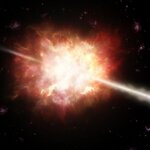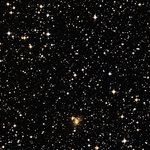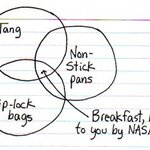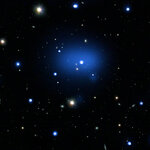Space

An explosion detected on April 23 by NASA's Swift satellite was more than 13 billion light-years from Earth, representing an event that occurred 630 million years after the Big Bang, when the Universe was only four percent of its current age of 13.7 billion years.
Astronomers turned telescopes from around the world to study the blast, dubbed GRB 090423. National Science Foundation's Very Large Array (VLA) first looked for the object the day after the discovery, detected the first radio waves from the blast a week later, then recorded changes in the object until it faded from view more…

A new star is known: CoRoT-7. It is one of the 100,000 stars that were recorded by the COROT satellite in 1,000 days since the December 27, 2006 launch date. Congratulations!
Date: 16 Sep 2009Depicts: Star field around CoRoT 7Copyright: ESO/Digitized Sky Survey
The star CoRoT-7 lives far away at around 500 light-years towards the constellation of Monoceros or the Unicorn. Younger than the closest star to us, the Sun, by about 3 billion years, CoRoT-7 has two planets. Both planets have masses in the super-Earth category. CoRoT-7c, like its sister CoRoT-…

A new star is known: CoRoT-7. It is one of the 100,000 stars that were recorded by the COROT satellite in 1,000 days since the December 27, 2006 launch date. Congratulations!
Date: 16 Sep 2009Depicts: Star field around CoRoT 7Copyright: ESO/Digitized Sky Survey
The star CoRoT-7 lives far away at around 500 light-years towards the constellation of Monoceros or the Unicorn. Younger than the closest star to us, the Sun, by about 3 billion years, CoRoT-7 has two planets. Both planets have masses in the super-Earth category. CoRoT-7c, like its sister CoRoT-…

Nothing happened Tuesday in space science, is the conclusion reached by this researcher. As a hard scientist here at ScientificBlogging, I find interesting topics to write about twice weekly. However, today, there was nothing. Nothing at all happened in science, at least involving space, or astronomy, or Mayans (who, according to /., apparently predicted the apocalypse in 2220, not 2012 as commonly misreported).
The NASA Ares-X launch was postponed due to bad weather and risk of triboelectrification. This NASA lead set the trend for 'nothingness' that continued up until I wrote this piece.…

I have known Marco Cardin for a couple of years because besides being an accomplished amateur astro-imager he is also an avid visual observer. His encyclopedic knowledge of the night sky wonders is a great help on the field during the monthly night-long observations in dark, moonless nights we spend on the eastern Alps, trying to squeeze the most out of the 16" Dobson telescopes we carry with us. These instruments have no fancy "go-to" features, but with Marco's help and organization we can frame close to 100 rarely seen objects per night. Recently Marco won a prestigious award for his work…

In the grand tradition of plotting things to make them interesting, we have (from the excellent webtoon Indexed), Pancakes from space:
Ironically, NASA didn't invent tang, teflon or ziplock, though NASA (who I feel is rather poor at marketing) provided Tang and velcro with a marketing edge that resulted in them becoming popular products. In addition to the usually cited true NASA spinoffs like better LEDs, heart pumps, lubricants, safety fabrics, radiation detectors, and solar panels, I found some odd ones.
It turns out NASA is also responsible for (among others things)... grooved highways,…

The most distant galaxy cluster yet, known as JKCS041, has been discovered by combining data from NASA's Chandra X-ray Observatory and optical and infrared telescopes at the United Kingdom Infrared Telescope (UKIRT), the Canada-France-Hawaii telescope in Hawaii and NASA's Spitzer Space Telescope. The JKCS041 cluster is located about 10.2 billion light years away, and is observed as it was when the Universe was only about a quarter of its present age.
The previous record holder for a galaxy cluster was 9.2 billion light years away, XMMXCS J2215.9-1738, discovered by ESA's XMM-Newton in 2006,…

A Canadian SUV was just hit by a meteorite. Some people have all the luck
For most of recorded history, no one had ever been hit by a meteorite. This was a useful factoid for us scientists when speaking to the public. It reaffirmed both probability-- how little of the Earth's surface area we cover-- and safety concerns.
Then, in 1823 it all changed. A horse was hit. Life had been damaged from space for the first time on record.
After that, reports of human impact began pouring in. Well, if you count 14 dubious claims as a flood. Why, just this year, another a person was hit, and just for…
The 2009 Great World Wide Star Count is already under way, and there is still time to wait for a perfectly pleasant fall evening to step outside and count the stars. Through October 23, this annual citizen science event from Windows to the Universe of the University Corporation for Atmospheric Research (UCAR) will be accepting online data collection from amateurs around the world.
Using observational techniques first developed by the Greek astronomer, Hipparchus (learn more about astronomer's magnitude scale), participants are asked to view a particular constellation--depending on your…

A new groups of exoplanets announced today comprises no less than 32 new discoveries. Including these new results, data from HARPS have led to the discovery of more than 75 exoplanets in 30 different planetary systems.
In 1999, ESO launched a call for opportunities to build the High Accuracy Radial Velocity Planet Searcher, better known as HARPS, a high resolution, extremely precise spectrograph for the ESO 3.6-meter telescope at La Silla, Chile. HARPS was installed in 2003 and was soon able to measure the back-and-forward motions of stars by detecting small changes in a star's radial…